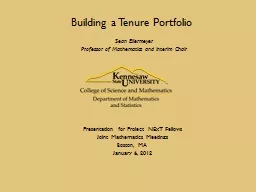

Sean Ellermeyer Professor of Mathematics and Interim Chair Presentation for Project NExT Fellows Joint Mathematics Meetings Boston MA January 6 2012 My Experience with the Tenure and Promotion Process at KSU ID: 630201
Download Presentation The PPT/PDF document "Building a Tenure Portfolio" is the property of its rightful owner. Permission is granted to download and print the materials on this web site for personal, non-commercial use only, and to display it on your personal computer provided you do not modify the materials and that you retain all copyright notices contained in the materials. By downloading content from our website, you accept the terms of this agreement.
Slide1
Building a Tenure Portfolio
Sean
EllermeyerProfessor of Mathematics and Interim Chair
Presentation for Project
NExT
Fellows
Joint Mathematics Meetings
Boston, MA
January 6, 2012Slide2
My Experience with the Tenure and Promotion Process at KSU
Candidate
Department Level Committee
College Level Committee
University Level Committee
Department Chair
University Process Review CommitteeSlide3
The Typical Career Path for Tenure Track Faculty
Hired as Assistant Professor
Promotion to Associate Professor
Promotion to Full Professor
Awarded in recognition that a new career milestone has been reached
Tenure
A commitment by your institution to make a long term investment in youSlide4
General Tips for Preparing a Successful Tenure and/or Promotion Portfolio
Follow your institution’s portfolio preparation guidelines. Follow page formatting instructions. Include all required documentation. Choose optional documentation judiciously. Don’t go overboard on including redundant documentation. Review committees will not appreciate this and it may appear that you are trying to “pad” your portfolio.
Do not obfuscate. Describe the most important activities that you have engaged in (using plain language) and how these activities are manifestations of your overall scholarly plan. Avoid using excessive “flowery” language.
Have some experienced colleagues look over your portfolio and give you advice before submitting it.
Give yourself ample time to prepare the portfolio. (Portfolios that are prepared hurriedly are easily identified and reflect negatively on the applicant.)
Be sure that any areas of needed improvement that were pointed out in annual reviews and other progress reviews have been addressed.Slide5
Making a Strong Case for Tenure
Don’t be an “independent contractor”: Participate in department life and get to know your colleagues. Demonstrate that you care about the growth and vitality of your department and that you can be counted on to be a contributor toward achieving departmental goals.
Try to establish a “niche” for yourself in which you are recognized as the leader. This could be an internal or external niche. It should be something that interests you and is well-suited to your particular qualifications. It might be something that arises through a call for a volunteer or, better yet, something that arises through your own initiative.
Start doing this right away! At the time of your tenure review, you want to be able to establish that your participation in department life has been sustained over a period of time and shows promise of continuing and moving toward increased leadership status.Slide6
Making a Strong Case for Promotion
Your portfolio (narrative, c.v., supporting documentation) should be able to answer the question “Who are you?” to anybody who reads it (not just those most familiar with your
work
).
Carry out your scholarly activity according to a systematic agenda. Focus your activities (teaching, research, service) around one or two “themes” that will define you to others. Don’t just engage in activities in a haphazard fashion.
Make sure that your work is externally reviewed and provide documentation of such review.
For collaborative work, it is essential that your specific roles and contributions be made clear. You should be able to demonstrate a progression toward leadership on projects (first or solo author on papers, leadership roles on committees, etc.)
Do not look at your department tenure and promotion guidelines as a “checklist” of activities to be completed. The quality and cohesiveness of your work is more important than the quantity.Slide7
Summary
Your bid for tenure and/or promotion is more likely to go smoothly if your colleagues (and administrators) already have a pretty good idea about “who you are” before they even read the portfolio that you submit. This can be achieved by being active in department (and college and university) life and publicizing what you do to others through presentations of your work and leadership roles that you assume. The purpose of the portfolio is then to provide the details of your work presented as an organized and cohesive package.